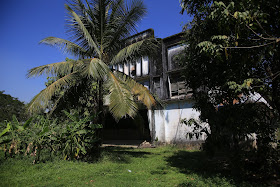Actually, the reasons are two fold. One, as I stand awkwardly on the doorstep of middle age, I've begun to care a bit more about my personal finances. Meaning I'd like to have some to speak of.
The second and more pressing reason is that what's left of my creative juices are being squeezed out into a book on Thailand's movie theater. In fact, it's called just that: "Thailand's Movie Theaters: relics, ruin and the romance of escape." After many delays and restarts, there is finally light at the end of the tunnel. Writing for a book, unlike writing for a piss-ant personal blog like this, is no easy feat. Not for a mediocre like me, anyhow. So rather than squander my creativity on senseless blog posts, I've been rerouting them to said book. Again, no easy task.
But in the name of keeping the SEAMTP faithful happy (if any of you still exist), here is a mini-post to prove, once and for all, that I still love doing this work, and that as long as there's a few people out there willing to read what I write and look at my pictures, I'll fulfill my end of the non-existent social contract we don't have between us.
--------------------------------------------------------------------------------------------------------------------------------
Welcome to carbon monoxide corner. Better known as Rangsit. Thailand's tailpipe. The most charmless blotch of civilization ever. Within this context of ten-lane, at-grade highways and sub-brutalist retail blocks - completely devoid of plant life - stands an equally charmless stand-alone movie theater.
Say hello to the Petch Rangsit Theater. In its current condition, it's the type of place where street dogs go to die, but not before defecating in it while they're living. Whatever type of grace-saving signage this building once had has been removed, leaving a featureless concrete box covered in soot and tropical mold.
Rangsit was apparently once a relatively charming Bangkok hinterland. An agriculturally productive area highlighted by the eponymous Rangsit Canal. When built, the canal was one of those key infrastructure projects that solidifies a place's economic clout. After completion in the early 1900's, the canal helped further centralize Bangkok as the nation's commercial hub by connecting the Chao Phraya River with the Nakorn Nayok River and opening up huge swaths of land to agricultural production.
The canal made Rangsit into a junction from the beginning. But since the arrival of the highway system, Rangsit has been transformed into one of the country's biggest transit corridors, hence the pollution and general lack of charm.
By the looks of it, The Petch Rangsit Theater was built in the early 1980's, part of the larger commercial quarter described in not-so-glowing terms above. An edge city development predicated on cars and buses from the get go. The lot in front of the theater, in fact, is now a local bus terminus, which indicates that the theater was built to capture that transitory population.
In its working days, the Petch Rangsit was a second run theater that was routinely programmed with triple features, a business model which fits the come-and-go needs of a transient clientele.
Of the several thousand people that pass it on a daily basis en route to or from Bangkok and points beyond, very few likely have an inkling of what it was, or that it once made this slice of automotive hell a little bit better.





















































